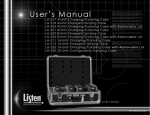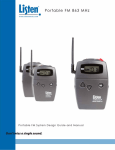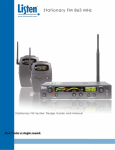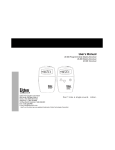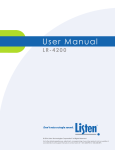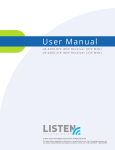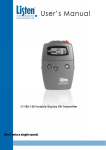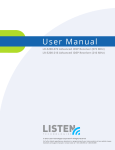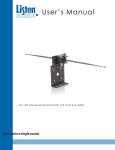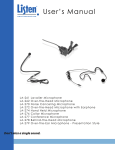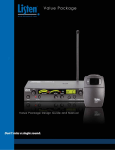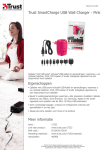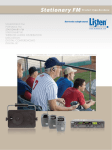Download Listen Technologies LR-300 User's Manual
Transcript
Dear Valued Customer, Thank you for choosing Listen! All of us at Listen are dedicated to providing you with the highest quality products available. We take great pride in their outstanding performance because we care that you are completely satisfied. That’s why we independently certify them to the highest quality standards and back them with a limited lifetime guarantee. We stand ready to answer any questions you might have during installation or in the operation of our products. Should you experience any problems whatsoever with your Listen products, we are ready to help you in any way we can with prompt, efficient customer care. Because at Listen, it’s all about you! And should you have any comments on how we might improve our products or our service, we’re here to listen. Here’s how to reach us: +1.801.233.8992 +1.800.330.0891 North America +1.801.233.8995 fax [email protected] www.listentech.com Thank you and enjoy your listening experience! Best regards, Russell Gentner and the Listen Team • In the few instances where repairs were needed, 99% of all clients indicated that they were happy with repair turn-around-times and 85% of the time, clients were without their product for less than 10 days! • Overall client satisfaction of working with Listen was rated 4.8 out of 5. • “Please continue with your excellent attitude toward customer satisfaction. You guys are great!” • “I’ve never had such good service from any company. Keep up the good work!” • “You stand behind your product wonderfully.” Assistive Listening • Language Interpretation • Soundfield • Tour Group • Conferencing Supplementary Information Channel Selection Listen SQ™ RF Reception Maximization Strategies 72 MHz Frequency Compatibility Table 216 MHz Frequency Compatibility Table Troubleshooting Compliance Notice FCC Statement Warranty Contacting Listen Optional Accessories 44 44 45 46 47 48 49 51 51 52 52 53 LR-400 3 5 19 21 33 35 LR-500 LR-500 Manual LR-500 Table of Contents LR-400 Manual LR-400 Table of Contents LR-300 Manual LR-300 Table of Contents Table of Contents Receivers Table of Contents LR-300 Information LR-500 Table of Contents 6 7 7 7 9 11 13 14 14 15 16 LR-500 Package Contents Architectural Specifications Specifications Quick Reference Setup Instructions Operation Instructions Programming Instructions Squelch Information Squelch Programming Charging Batteries Wall Transformer Operation 5 LR-500 Package Contents LR-500 Contents LR-500 • LR-500 Portable Programmable Display FM Receiver (72 MHz, 216 MHz) Listen Part Number •LR-500-072 (72 MHz) •LR-500-216 (216 MHz) 3 3 6 LR-500 Specifications Architectural Specifications LR-500 The FM reciever shall be capable of receiving on 57 wide and narrow band channels with a SNR of 80dB or greater. The receiver shall be programmable to electronically lock out unneeded channels. The receiver shall be capable of seeking channels. The device shall have an adjustable squelch. The device shall have an audio frequency response of 63 Hz to 15 KHz, ± 3dB at 72 MHz, or 63 Hz to 10 KHz, ±3dB at 216 MHz. The device will incorporate a stereo headset jack that allows the user to plug in either a mono or stereo headset. The device shall incorporate an LCD display that indicates channel, channel lock or lock status, battery level, battery charging, and RF signal strength. The receiver shall incorporate automatic battery charging circuitry for recharging of NiMH batteries. The Listen LR-500 is specified. Specifications Specification RF LR-500-072 LR-500-216 RF Frequency Range 72.025-75.950 MHz 216.025-216.975 MHz Number of Channels 57 (17 wide, 40 narrow) 57 (19 wide, 38 narrow) Sensitivity .6uV typical, 1 uV maximum for 12dB SINAD Frequency Accuracy ± .005% stability 32 to 122º F (0 to 50º C) Antenna Uses earphone cable Antenna Connector 3.5 mm connector Squelch Programmable in 20 steps Compliance FCC Part 15, Industry Canada ** All system specifications are wireless end-to-end System Frequency Response Audio Controls Physical Environmental 63 Hz-10 kHz (±3dB) SQ™ enabled: 80dB; SQ™ disabled: 50dB System Distortion < 2% total harmonic distortion (THD) at 80% deviation Output 3.5 mm connectors, unbalanced, 0dBu nomial output level, 16mW maximum, impedance 32 Ohms Set Up Controls Programmable channel selection (see below), alkaline/NiMH batteries and squelch, SQ™ enable/disable User Controls Volume, channel UP/DOWN/SEEK. All controls except volume are electronically lockable Programming Unit can be programmed so that only desired channels are displayed. Squelch can be adjusted for sensitivity and signal capture control. Channel selection can be locked by holding the SEEK button for 5 seconds. LCD Display Indicates channel, RF signal strength, lock status, squelch, battery power level and channel programming LED Red, illuminates when unit is on. Flashes when batteries are low. Flashes when charging. Flashes when locked and user attempts to seek to another channel. Battery Type Two AA batteries, alkaline or NiMH Indicators Power 63 Hz-15 Hz (±3dB) System Signal to Noise Ratio (A-weighted) SQ™ enabled: 80dB; SQ™ disabled: 60dB Battery Life (Listen batteries) 30 hours alkaline (LA-361), 15 hours NiMH rechargeable (LA-362) Battery Charging (NiMH only) Fully automatic, 14 hours Power Supply Connector 2.3 mm OD by 0.7 mm ID, barrel type connector. 7.5VDC, center positive <250mA. Drop in contact points for use with Listen charging cases Compliance UL Listed Dimensions W x D x H 3.0 x 1.0 x 4.25 in. (7.6 x 2.5 x 13 cm) Unit Weight 3.9 oz. (111 g) Unit Weight with batteries 5.8 oz. (164.4 g) Shipping Weight 1.0 lbs. (453.6 kg) Door Manually lockable. UP, DOWN and SEEK through door, other controls behind door (see Controls above) Temperature - Operation 14 to 104º F (10 to 40º C) Temperature - Storage -4 to 122º F (-20 to 50º C) Humidity 0 to 95% relative humidity, non-condensing 7 LR-500 Quick Reference 3.5 mm Output Jack: Connect a Listen earphone(s) here. LED: When lit, indicates unit has power. When batteries are low or charging the LED flashes On/Off and Volume Control Dial LR-500 Articulating Flexible Antenna: Place in upright position when in use. Look&Listen™ Display: Shows receive level, channel, programming, battery status, and lock status. Power/Charging Port SEEK Button: Allows the user to search for or lock onto an active channel. Channel Select Buttons Battery Select Switch: Choose the type of batteries being used - Alkaline or NiMH. Front Door Lock SQ™ Switch: Turns SQ™ On/Off. Battery Compartment: Place two (2) AA batteries in compartment. Be sure to follow polarity pattern. Channel Display: Displays the channel the LR-500-863 is currently on. RF Receive Indicator: Indicates the RF receive level. Battery Level Indicator PGM: Program function is in process. L/O: Indicates while in programming mode the specific channel has been locked out. Lock Icon: Indicates the unit is locked on current channel. 8 LR-500 Setup Instructions 1 Remove the product 2 Open the front access door Remove outer packaging and plastic cover. Inspect for physical damage. If damage is apparent, please contact Listen Technologies Corporation technical support for assistance. If locked, use a pocketknife or small screwdriver to unlock the door locks on both sides of the unit. To unlock the door, rotate the lock 1/4 turn counterclockwise. 3 LR-500 Grip the two tabs with your thumb and index finger and pull the door downward. Do NOT place batteries in the unit yet. Select Battery Type You have two choices: NiMH and Alkaline. The unit is shipped with the switch in the Alkaline position. Use a pen or small screwdriver to select the battery type. Unlocked Locked CAUTION: If you are using any battery type other than rechargeable Nickel Metal Hydride (NiMH) batteries, make sure the BATTERY selection switch is in the alkaline position. WARNING: Do not place the BATTERY switch in the NiMH position if you are not using Nickel Metal Hydride Batteries. The NiMH position will attempt to charge any batteries in the unit, even if they are not the proper type. Charging non-Nickel Metal Hydride (NiMH) batteries will result in physical harm, destruction of property and/or fire. 4 Set SQ switch The SQ switch is inside the battery compartment next to the Battery Select switch. The unit is shipped with SQ in the ON position. To turn it off, use a small screwdriver or pen to slide the switch to the OFF position (to the right). See page 45 for more information on SQ. SQ™ Select Switch Battery Select Switch 5 Place Batteries in Unit Place two AA batteries in the compartment, making note of the battery polarity shown in the battery compartment, and again verifying that the BATTERY SELECT switch is in the correct position for the batteries you are using. (ALK should be selected for all battery types other than NiMH). NOTE: Listen provides industrial strength AA alkaline batteries (part number LA-361) and high performance AA Nickel Metal Hydride batteries (part number LA-362). These may be purchased from your Listen dealer. 9 LR-500 Setup Instructions Connect an Earphone or Headset 7 Turn the Unit On 8 Select Channel(s) 9 Set Squelch 10 Program Channels LR-500 6 Your headset or earphone will connect to the jack on the top of the unit. Either mono or stereo connectors may be used with a Listen receiver. Make certain you push the plug all the way into the jack. Receivers are turned on by rotating the volume dial counterclockwise. The red LED on top of the unit should activate and the LCD display should illuminate. If they do not, make sure you have installed the batteries correctly and that you are using fully charged batteries. See page 44 for complete channel selection information. See pages 13 and 14 for squelch and programming information. see page 13. Red LED will illuminate when on Earphone/Headset jack LCD display will activate when on 10 Turn volume knob counterclockwise to turn on LR-500 Operation Instructions 1 Make Sure the Unit is On Rotate the volume knob counterclockwise with an earphone or headset connected to the unit. Listen receivers use the cable of the earphone or headset as a receiving antenna. Be careful when turning the unit on - if you turn the knob too far you might get too much volume in your earphone! 2 Select a Channel LR-500 Select the channel to match the transmission channel by pressing the UP and DOWN buttons on the receiver. Listen recommends the use of wide band channels. At 72 MHz: 72 MHz receivers operate on 17 wide band channels and 40 narrow band channels. Channels represented by letters on the display (i.e. A) are wideband channels; channels represented by numbers are narrowband channels. At 216 MHz: 216 MHz receivers operate on 19 wide band channels and 38 narrow band channels. Channel numbers starting with a “2” are wide band; channels beginning with a “1” or “3” are narrow band channels. Refer to the Frequency Compatibility Tables (pages 47-48) for specific frequencies and compatibility with other manufacturers. 3 Test the audio 4 Find an audio transmission using SEEK 5 Adjust the volume control If a transmitter is broadcasting on that channel, you will be able to hear the audio. If the signal is too weak, the audio will be muted (squelched). Another way to find a channel on the LR-500 is to use the SEEK button. When you do this, the Listen receiver looks for the next active channel. Sometimes the unit will mistake interference for a real broadcast signal. If you get interference, press the SEEK button again. The unit may stop on a channel that is close to the actual broadcast channel, in which case the channel will sound noisy or distorted. Simply press SEEK again until you find the clearest operating channel. Use the control dial on the top of the unit to adjust the volume to a comfortable level. Volume Control Dial 11 LR-500 Operation Instructions 6 To Lock into Only One Channel Press and hold the SEEK button for 5 seconds to lock a receiver onto the currently tuned channel. Press and hold the button again to unlock. When locked the LED on top of the unit will flash when you press the SEEK button. Is the Channel Locked on My Receiver? LR-500 On the LR-500, when the channel is locked, the padlock icon will appear on the display. If the unit is locked, the red LED on the top of the unit will flash when you press the SEEK button. If locked, LED flashes on all portable receivers when SEEK button is pressed Padlock appears when locked 12 LR-500 Programming Instructions The LR-500 Display Receiver has some special features not available in the other receivers: you may lock out unwanted channels, and you can adjust the squelch in the unit. Locking Out Unwanted Channels For applications where users are required to select a channel (such as language interpretation or classrooms), and you don’t want them to have to go through all 57 available channels to find the appropriate channel, you can lock out all channels except the ones you are using in your facility. UP and DOWN buttons on front of LR-500 LR-500 1 Enter the PROGRAM mode 2 Use the UP and DOWN keys to select channels 3 Press the SEEK button to toggle channels between locked out and non-locked out modes Press the UP and DOWN buttons simultaneously for 5 seconds, until the PGM symbol appears in the display. As channels are displayed on the unit, those channels that are locked out from user access will be indicated by the L/O (Locked Out) symbol. When a channel is locked out, the receiver will skip over that channel when a user is tuning the receiver. Exiting PROGRAM mode To exit the PROGRAM mode, let the receiver sit idle (don’t press any buttons) for 5 seconds. The receiver will automatically return to normal operation. If you haven’t finished programming the unit and it automatically exits, press and hold the UP & DOWN buttons simultaneously for 5 seconds to re-enter the PROGRAM mode. 13 LR-500 Squelch Squelch The purpose of squelch is to mute the audio output of your receiver when the signal from the transmitter is turned off or is too weak to be received. Without squelch you would hear radio noise in your earphone. The squelch on your receiver can be adjusted so that it will mute the audio on different RF signal strengths. This is useful as follows: LR-500 • To ensure that users don’t hear transmissions from other transmitters, set the squelch setting to the highest level that doesn’t squelch the receiver. • If the receiver is going to be close to the transmitter (i.e. in a classroom), setting the squelch setting high so that when the transmitter is turned off it immediately squelches and ignores transmitters in other rooms. • If you are in an area that has a lot of inference, you may want to set the squelch setting to a high setting to ensure the interference is not picked by the receiver. • If you need the maximum amount of range, you may want to consider setting the squelch setting to a low level (0, 1 or 2). CAUTION: When setting the squelch level low the reliability of squelch function is comprised. This will cause radio noise to be heard in the earphone and there is a possibility of hearing damage. Squelch Programming Instructions Squelch Programming To enter Squelch programming mode • Turn the unit off • Press and hold the seek button; while still holding seek turn the ON/OFF dial to turn the unit on. • Release the seek button when the Listen name disappears and a two digit display is seen. To adjust the Squelch level • Use the Channel UP and DOWN buttons to raise or lower the squelch sensitivity settings. • Lower numbers mean that a less powerful and possibly noisy signal will be heard, but you can have a longer range. • Higher numbers mean that a more powerful signal with no noise will be heard, but you may have a shorter range. • Once the desired squelch setting is found, press “seek” to exit the squelch programming mode. Squelch setting 00 is no squelch; this effectively disables Squelching capabilities of the receiver. Squelch setting 20 is maximum squelch sensitivity; you must have a very strong and stable RF signal for the unit to not engage the squelch feature. Adjusting the squelch setting will keep your LR-500 receiver from picking up noise when the transmitter is not transmitting, or when you lose the signal by being out of range or if encountering interference. Note: For squelch settings 1-3, the squelch function is slow which allows for maximum transmission range. For squelch settings 4-20 the squelch function is fast to ensure little radio noise is heard during the squelch function. (The Listen SQ™ feature is not squelch, please refer to page 45 for information on Listen SQ™). 14 LR-500 Charging Batteries The LR-500 and all Listen receivers are unique because they have SmartCharge™ chargers built in. When any of these units are connected to an LA-202 wall transformer or dropped into a Listen charging case, NiMH batteries will be charged. To charge the batteries using the LA-202 wall transformer, plug the transformer into the jack marked “PWR/CHG” on the side of the unit. The unit can be operated while the batteries are charging. 2 To charge the batteries using a drop-in charger, simply place the unit into a slot in the charger and connect the charger to power. Make sure the unit is fully seated in its slot. LR-500 1 SmartCharge™ uses a pulse charging, which greatly extends the life of Nickel Metal Hydride (NiMH) batteries. The entire charging process takes 13 hours. Listen recommends that you allow the charger to complete its full cycle every time for maximum battery life. NOTE: In order to charge NiMH batteries, the BATTERY SELECT switch in your Listen product must be set to the NiMH setting. Use a pen or small screwdriver to move the switch (located in the battery compartment) to the proper position. Connect LA-202 here and plug into an AC wall outlet IMPORTANT: DO NOT ATTEMPT TO CHARGE ANY TYPE OF BATTERY OTHER THAN NiMH (NICKEL METAL HYDRIDE) with your Listen equipment. Alkaline batteries may explode when connected to a charger. Other risks of charging non-NiMH batteries include destruction of property or fire. During the charge cycle, the red LED on top of the Listen product will flash slowly. When charging is completed, the LED will turn off. It is not necessary to unplug the charger; however, if you unplug the unit from the charger and then plug it back in, it will begin the 13-hour charge cycle over again. When not using the LR-500, it is recommended to leave the unit on the charger. The charger provides a “maintenance” charge that keeps the battery at 100%. If the unit is not on the charger, the battery will lose up to 20% of its charge per month. NOTE: Listen provides high performance constant current NiMH (Nickel Metal Hydride) batteries. These may be purchased from your Listen dealer (ask for part number LA-362). 15 LR-500 Wall Transformer Operation The LR-500 will operate normally when connected to a wall transformer. Use Listen part number LA-202, available from any Listen dealer. Connect the wall transformer to the jack on the side of the LR-500 marked “PWR/CHG” and plug the wall transformer into a grounded AC outlet. You do not need to have batteries installed in the LR-500 to operate it with a wall transformer. LR-500 NOTE: If batteries are in the unit ensure that the battery selection switch is set properly as shown on page 9. Please review the information on page 15 for important information regarding battery type and charging. www.listentech.com The LA-202 wall transformer plugs into the side of your portable transmitter or receiver 16 LR-400 Table of Contents Package Contents Architectural Specifications Specifications Quick Reference Setup Instructions Operation Instructions Squelch Information Squelch Programming Charging Batteries Wall Transformer Operation 22 23 23 24 25 27 29 29 30 31 LR-400 21 LR-400 Package Contents LR-400 Contents • LR-400 Portable Display FM Receiver (72 MHz, 216 MHz) Listen Part Number LR-400 •LR-400-072 (72 MHz) •LR-400-216 (216 MHz) 22 LR-400 Specifications Architectural Specifications The FM receiver shall be capable of receiving on 57 wide and narrow band channels with a SNR of 80dB or greater. The receiver shall be capable of seeking channels. The device shall have an adjustable squelch. The device shall have an audio frequency response of 63 Hz to 15 KHz, ± 3dB at 72 MHz, or of 63 Hz to 10 kHz, ± 3dB at 216 MHz. The device will incorporate a stereo headset jack that allows the user to plug in either a mono or stereo headset and listen to the audio normally. The device shall incorporate an LCD display that indicates channel, battery level, low battery, battery charging, RF signal strength and channel lock status. The receiver shall incorporate automatic battery charging circuitry for recharging of NiMH batteries. The Listen LR-400 is specified. Specifications Specification RF LR-400-072 LR-400-216 RF Frequency Range 72.025-75.950 MHz 216.025-216.975 MHz Number of Channels 57 (17 wide, 40 narrow) 57 (19 wide, 38 narrow) Sensitivity .6uV typical, 1 uV maximum for 12dB SINAD ± .005% stability 32 to 122º F (0 to 50º C) Antenna Uses earphone cable Antenna Connector 3.5 mm connector Squelch Programmable in 20 steps Compliance FCC Part 15, Industry Canada LR-400 Frequency Accuracy ** All system specifications are wireless end-to-end System Frequency Response Audio Power Physical Environmental 63 Hz-10 kHz (±3dB) SQ™ enabled: 80dB; SQ™ disabled: 50dB System Distortion < 2% total harmonic distortion (THD) at 80% deviation Output 3.5 mm connectors, unbalanced, 0dBu nomial output level, 16mW maximum, impedance 32 Ohms Set Up Controls Alkaline/NiMH batteries and SQ™ enable/disable and programmable squelch setting User Controls Volume, channel UP/DOWN/SEEK (All controls except volume are electronically lockable, and are behind the door) Programming Squelch can be adjusted for sensitivity and signal capture control. Channel selection can be locked by holding the SEEK button for 5 seconds. Unit cannot be programmed to seek only used channels, however, it is capable of entering squelch mode. LCD Display Indicates channel, RF signal strength, lock status, and squelch setting LED Red, illuminates when unit is on. Flashes when batteries are low. Flashes when charging. Flashes when locked and user attempts to seek to another channel. Battery Type Two AA batteries, alkaline or NiMH Controls Indicators 63 Hz-15 Hz (±3dB) System Signal to Noise Ratio (A-weighted) SQ™ enabled: 80dB; SQ™ disabled: 60dB Battery Life (Listen batteries) 30 hours alkaline (LA-361), 15 hours NiMH rechargeable (LA-362) Battery Charging (NiMH only) Fully automatic, 14 hours Power Supply Connector 2.3 mm OD by 0.7 mm ID, barrel type connector. 7.5VDC, center positive <250mA. Drop in contact points for use with Listen charging/carrying cases Compliance UL Listed Dimensions W x D x H 3.0 x 1.0 x 4.25 in. (7.6 x 2.5 x 13 cm) Unit Weight 3.9 oz. (111 g) Unit Weight with batteries 5.8 oz. (164.4 g) Shipping Weight 1.0 lbs. (453.6 kg) Door Manually lockable. UP, DOWN and SEEK protected by door Temperature - Operation 14 to 104º F (10 to 40º C) Temperature - Storage -4 to 122º F (-20 to 50º C) Humidity 0 to 95% relative humidity, non-condensing 23 LR-400 Quick Reference 3.5 mm Output Jack: Connect a Listen earphone(s) here. LED: When lit, indicates unit has power. When batteries are low or charging the LED flashes On/Off and Volume Control Dial Look&Listen™ Display: Shows receive level, channel, programming, battery status, and lock status. Power/Charging Port SEEK Button: Allows the user to search for or lock onto an active channel. Channel Select Buttons Battery Select Switch: Choose the type of batteries being used - Alkaline or NiMH. Front Door Lock SQ™ Switch: Turns SQ™ On/Off. LR-400 Battery Compartment: Place two (2) AA batteries in compartment. Be sure to follow polarity pattern. Channel Display: Displays the channel the LR-500-863 is currently on. RF Receive Indicator: Indicates the RF receive level. Battery Level Indicator Lock Icon: Indicates the unit is locked on current channel. 24 LR-400 Setup Instructions 1 Remove the product 2 Open the front access door Remove outer packaging and plastic cover. Inspect for physical damage. If damage is apparent, please contact Listen Technologies Corporation technical support for assistance. If locked, use a pocketknife or small screwdriver to unlock the door locks on both sides of the unit. To unlock the door, rotate the lock 1/4 turn counterclockwise. Grip the two tabs with your thumb and index finger and pull the door downward. Do NOT place batteries in the unit yet. 3 Select Battery Type You have two choices: NiMH and Alkaline. The unit is shipped with the switch in the Alkaline position. Use a pen or small screwdriver to select the battery type. Unlocked Locked CAUTION: If you are using any battery type other than rechargeable Nickel Metal Hydride (NiMH) batteries, make sure the BATTERY selection switch is in the alkaline position. LR-400 WARNING: Do not place the BATTERY switch in the NiMH position if you are not using Nickel Metal Hydride Batteries. The NiMH position will attempt to charge any batteries in the unit, even if they are not the proper type. Charging non-Nickel Metal Hydride (NiMH) batteries will result in physical harm, destruction of property and/or fire. 4 Set SQ switch The SQ switch is inside the battery compartment next to the Battery Select switch. The unit is shipped with SQ in the ON position. To turn it off, use a small screwdriver or pen to slide the switch to the OFF position (to the right). See page 45 for more information on SQ. SQ™ Select Switch Battery Select Switch 5 Place Batteries in Unit Place two AA batteries in the compartment, making note of the battery polarity shown in the battery compartment, and again verifying that the BATTERY SELECT switch is in the correct position for the batteries you are using. (ALK should be selected for all battery types other than NiMH). NOTE: Listen provides industrial strength AA alkaline batteries (part number LA-361) and high performance AA Nickel Metal Hydride batteries (part number LA-362). These may be purchased from your Listen dealer. 25 LR-400 Setup Instructions 6 Connect an Earphone or Headset 7 Turn the Unit On 8 Select Channel(s) 9 Set Squelch Your headset or earphone will connect to the jack on the top of the unit. Either mono or stereo connectors may be used with a Listen receiver. Make certain you push the plug all the way into the jack. Receivers are turned on by rotating the volume dial counterclockwise. The red LED on top of the unit should activate and the LCD display should illuminate. If they do not, make sure you have installed the batteries correctly and that you are using fully charged batteries. See page 44 for complete channel selection information. LR-400 See page 29 for squelch and programming information. Red LED will illuminate when on Earphone/Headset jack LCD display will activate when on 26 Turn volume knob counterclockwise to turn on LR-400 Operation Instructions 1 Make Sure the Unit is On Rotate the volume knob counterclockwise with an earphone or headset connected to the unit. Listen receivers use the cable of the earphone or headset as a receiving antenna. Be careful when turning the unit on - if you turn the knob too far you might get too much volume in your earphone! 2 Select a Channel Select the channel to match the transmission channel by pressing the UP and DOWN buttons on the receiver. Listen recommends the use of wide band channels. At 72 MHz: 72 MHz receivers operate on 17 wide band channels and 40 narrow band channels. Channels represented by letters on the display (i.e. A) are wideband channels; channels represented by numbers are narrowband channels. At 216 MHz: 216 MHz receivers operate on 19 wide band channels and 38 narrow band channels. Channel numbers starting with a “2” are wide band; channels beginning with a “1” or “3” are narrow band channels. Refer to the Frequency Compatibility Tables (pages 47-48) for specific frequencies and compatibility with other manufacturers. Test the audio 4 Find an audio transmission using SEEK 5 Adjust the volume control LR-400 3 If a transmitter is broadcasting on that channel, you will be able to hear the audio. If the signal is too weak, the audio will be muted (squelched). Another way to find a channel on the LR-400 is to use the SEEK button. When you do this, the Listen receiver looks for the next active channel. Sometimes the unit will mistake interference for a real broadcast signal. If you get interference, press the SEEK button again. The unit may stop on a channel that is close to the actual broadcast channel, in which case the channel will sound noisy or distorted. Simply press SEEK again until you find the clearest operating channel. Use the control dial on the top of the unit to adjust the volume to a comfortable level. Volume Control Dial 27 LR-400 Operation Instructions 6 To Lock into Only One Channel Press and hold the SEEK button for 5 seconds to lock a receiver onto the currently tuned channel. Press and hold the button again to unlock. When locked the LED on top of the unit will flash when you press the SEEK button. Is the Channel Locked on My Receiver? On the LR-400, when the channel is locked, the padlock icon will appear on the display. If the unit is locked, the red LED on the top of the unit will flash when you press the SEEK button. If locked, LED flashes on all portable receivers when SEEK button is pressed LR-400 Padlock appears when locked 28 LR-400 Squelch Squelch The purpose of squelch is to mute the audio output of your receiver when the signal from the transmitter is turned off or is too weak to be received. Without squelch you would hear radio noise in your earphone. The squelch on your receiver can be adjusted so that it will mute the audio on different RF signal strengths. This is useful as follows: • To ensure that users don’t hear transmissions from other transmitters, set the squelch setting to the highest level that doesn’t squelch the receiver. • If the receiver is going to be close to the transmitter (i.e. in a classroom), setting the squelch setting high so that when the transmitter is turned off it immediately squelches and ignores transmitters in other rooms. • If you are in an area that has a lot of inference, you may want to set the squelch setting to a high setting to ensure the interference is not picked by the receiver. • If you need the maximum amount of range, you may want to consider setting the squelch setting to a low level (0, 1 or 2). CAUTION: When setting the squelch level low the reliability of squelch function is comprised. This will cause radio noise to be heard in the earphone and there is a possibility of hearing damage. Squelch Programming Instructions LR-400 Squelch Programming To enter Squelch programming mode • Turn the unit off • Press and hold the seek button; while still holding seek turn the ON/OFF dial to turn the unit on. • Release the seek button when the Listen name disappears and a two digit display is seen. To adjust the Squelch level • Use the Channel UP and DOWN buttons to raise or lower the squelch sensitivity settings. • Lower numbers mean that a less powerful and possibly noisy signal will be heard, but you can have a longer range. • Higher numbers mean that a more powerful signal with no noise will be heard, but you may have a shorter range. • Once the desired squelch setting is found, press “seek” to exit the squelch programming mode. Squelch setting 00 is no squelch; this effectively disables Squelching capabilities of the receiver. Squelch setting 20 is maximum squelch sensitivity; you must have a very strong and stable RF signal for the unit to not engage the squelch feature. Adjusting the squelch setting will keep your LR-500 receiver from picking up noise when the transmitter is not transmitting, or when you lose the signal by being out of range or if encountering interference. Note: For squelch settings 1-3, the squelch function is slow which allows for maximum transmission range. For squelch settings 4-20 the squelch function is fast to ensure little radio noise is heard during the squelch function. (The Listen SQ™ feature is not squelch, please refer to page 45 for information on Listen SQ™). 29 LR-400 Charging Batteries The LR-400 and all Listen receivers are unique because they have SmartCharge™ chargers built in. When any of these units are connected to an LA-202 wall transformer or dropped into a Listen charging case, NiMH batteries will be charged. 1 To charge the batteries using the LA-202 wall transformer, plug the transformer into the jack marked “PWR/CHG” on the side of the unit. The unit can be operated while the batteries are charging. 2 To charge the batteries using a drop-in charger, simply place the unit into a slot in the charger and connect the charger to power. Make sure the unit is fully seated in its slot. SmartCharge™ uses a pulse charging, which greatly extends the life of Nickel Metal Hydride (NiMH) batteries. The entire charging process takes 13 hours. Listen recommends that you allow the charger to complete its full cycle every time for maximum battery life. NOTE: In order to charge NiMH batteries, the BATTERY SELECT switch in your Listen product must be set to the NiMH setting. Use a pen or small screwdriver to move the switch (located in the battery compartment) to the proper position. LR-400 Connect LA-202 here and plug into an AC wall outlet IMPORTANT: DO NOT ATTEMPT TO CHARGE ANY TYPE OF BATTERY OTHER THAN NiMH (NICKEL METAL HYDRIDE) with your Listen equipment. Alkaline batteries may explode when connected to a charger. Other risks of charging non-NiMH batteries include destruction of property or fire. During the charge cycle, the red LED on top of the Listen product will flash slowly. When charging is completed, the LED will turn off. It is not necessary to unplug the charger; however, if you unplug the unit from the charger and then plug it back in, it will begin the 13-hour charge cycle over again. When not using the LR-400, it is recommended to leave the unit on the charger. The charger provides a “maintenance” charge that keeps the battery at 100%. If the unit is not on the charger, the battery will lose up to 20% of its charge per month. NOTE: Listen provides high performance constant current NiMH (Nickel Metal Hydride) batteries. These may be purchased from your Listen dealer (ask for part number LA-362). 30 LR-400 Wall Transformer Operation The LR-400 will operate normally when connected to a wall transformer. Use Listen part number LA-202, available from any Listen dealer. Connect the wall transformer to the jack on the side of the LR-400 marked “PWR/CHG” and plug the wall transformer into a grounded AC outlet. You do not need to have batteries installed in the LR-400 to operate it with a wall transformer. NOTE: If batteries are in the unit ensure that the battery selection switch is set properly as shown on page 25. Please review the information on page 30 for important information regarding battery type and charging. LR-400 www.listentech.com The LA-202 wall transformer plugs into the side of your portable transmitter or receiver 31 LR-300 Table of Contents Package Contents Architectural Specifications Specifications Quick Reference Setup Instructions Operation Instructions Charging Batteries Wall Transformer Operation 36 37 37 38 39 41 42 43 LR-300 35 LR-300 Package Contents LR-400 Contents • LR-300 Portable Digital FM Receiver(72 MHz or 216 MHz) Listen Part Number LR-300 •LR-300-072 (72 MHz) 36 LR-300 Specifications Architectural Specifications The FM receiver shall be capable of receiving on 17 wide band channels and have a SNR of 80dB or greater. The receiver shall be capable of seeking channels. The device shall have a squelch. The device shall have an audio frequency response of 63 Hz to 15 KHz, ± 3dB at 72 MHz. The device shall incorporate a stereo headset jack that allows the user to plug in either a mono or stereo headset and listen to audio normally. The receiver shall incorporate automatic battery charging circuitry for recharging of NiMH batteries. The Listen LR-300 is specified. Specifications Specification RF LR-300-072 RF Frequency Range 72.025-75.950 MHz Number of Channels 17 (wide band) Sensitivity .6uV typical, 1 uV maximum for 12dB SINAD Frequency Accuracy ± .005% stability 32 to 122º F (0 to 50º C) Antenna Uses earphone cable Antenna Connector 3.5 mm connector Squelch Automatic on loss of RF signal Compliance FCC Part 15, Industry Canada ** All system specifications are wireless end-to-end System Frequency Response 63 Hz-15 kHz (± 3dB) System Signal to Noise Ratio (A-weighted) SQ™ enabled: 80dB; SQ™ disabled 60dB Audio Controls Indicators Power Environmental < 2% total harmonic distortion (THD) at 80% deviation Output 3.5 mm connectors, unbalanced, 0dBu nomial output level, 16mW maximum, impedance 32 Ohms Set Up Controls Alkaline/NiMH batteries, SQ™ enable/disable User Controls Volume, SEEK (Channel SEEK is electronically lockable) Programming Channel selection can be locked by holding the SEEK button for 5 seconds LED Red, illuminates when unit is on. Flashes when batteries are low. Flashes when charging. Flashes when locked and user attempts to seek to another channel. Battery Type Two AA batteries, alkaline or NiMH Battery Life (Listen batteries) 30 hours alkaline (LA-361), 15 hours NiMH rechargeable (LA-362) Battery Charging (NiMH only) Fully automatic, 14 hours Power Supply Connector 2.3 mm OD by 0.7 mm ID, barrel type connector. 7.5VDC, center positive <250mA. Drop in contact points for use with Listen charging cases Compliance UL Listed Dimensions W x D x H 3.0 x 1.0 x 4.25 in. (7.6 x 2.5 x 13 cm) Unit Weight 3.9 oz. (111 g) Unit Weight with batteries 5.8 oz. (164.4 g) Shipping Weight 1.0 lbs. (453.6 kg) Door Manually lockable. SEEK behind the door. Temperature - Operation 14 to 104º F (10 to 40º C) Temperature - Storage -4 to 122º F (-20 to 50º C) Humidity 0 to 95% relative humidity, non-condensing LR-300 Physical System Distortion 37 LR-300 Quick Reference 3.5 mm Output Jack: Connect a Listen earphone(s) here. LED: When lit, indicates unit has power. When batteries are low or charging the LED flashes On/Off and Volume Control Dial Power/Charging Port SEEK Button: Allows the user to search for or lock onto an active channel. Front Door Lock Battery Select Switch: Choose the type of batteries being used - Alkaline or NiMH. SQ™ Switch: Turns SQ™ On/Off. LR-300 Battery Compartment: Place two (2) AA batteries in compartment. Be sure to follow polarity pattern. 38 LR-300 Setup Instructions 1 Remove the product 2 Open the front access door Remove outer packaging and plastic cover. Inspect for physical damage. If damage is apparent, please contact Listen Technologies Corporation technical support for assistance. If locked, use a pocketknife or small screwdriver to unlock the door locks on both sides of the unit. To unlock the door, rotate the lock 1/4 turn counterclockwise. Grip the two tabs with your thumb and index finger and pull the door downward. Do NOT place batteries in the unit yet. 3 Select Battery Type You have two choices: NiMH and Alkaline. The unit is shipped with the switch in the Alkaline position. Use a pen or small screwdriver to select the battery type. Unlocked Locked CAUTION: If you are using any battery type other than rechargeable Nickel Metal Hydride (NiMH) batteries, make sure the BATTERY selection switch is in the alkaline position. WARNING: Do not place the BATTERY switch in the NiMH position if you are not using Nickel Metal Hydride Batteries. The NiMH position will attempt to charge any batteries in the unit, even if they are not the proper type. Charging non-Nickel Metal Hydride (NiMH) batteries will result in physical harm, destruction of property and/or fire. 4 Set SQ switch The SQ switch is inside the battery compartment next to the Battery Select switch. The unit is shipped with SQ in the ON position. To turn it off, use a small screwdriver or pen to slide the switch to the OFF position (to the right). See page 45 for more information on SQ. SQ™ Select Switch Battery Select Switch LR-300 5 Place Batteries in Unit Place two AA batteries in the compartment, making note of the battery polarity shown in the battery compartment, and again verifying that the BATTERY SELECT switch is in the correct position for the batteries you are using. (ALK should be selected for all battery types other than NiMH). NOTE: Listen provides industrial strength AA alkaline batteries (part number LA-361) and high performance AA Nickel Metal Hydride batteries (part number LA-362). These may be purchased from your Listen dealer. 39 LR-300 Setup Instructions 6 Connect an Earphone or Headset 7 Turn the Unit On Your headset or earphone will connect to the jack on the top of the unit. Either mono or stereo connectors may be used with a Listen receiver. Make certain you push the plug all the way into the jack. Receivers are turned on by rotating the volume dial counterclockwise. The red LED on top of the unit should activate and the LCD display should illuminate. If they do not, make sure you have installed the batteries correctly and that you are using fully charged batteries. Red LED will illuminate when on LR-300 Earphone/Headset jack 40 Turn volume knob counterclockwise to turn on LR-300 Operation Instructions 1 Make Sure the Unit is On Rotate the volume knob counterclockwise with an earphone or headset connected to the unit. Listen receivers use the cable of the earphone or headset as a receiving antenna. Be careful when turning the unit on - if you turn the knob too far you might get too much volume in your earphone! 2 Test the audio 3 Find an audio transmission using SEEK 4 Adjust the volume control If a transmitter is broadcasting on that channel, you will be able to hear the audio. If the signal is too weak, the audio will be muted (squelched). Another way to find a channel on the LR-300 is to use the SEEK button. When you do this, the Listen receiver looks for the next active channel. Sometimes the unit will mistake interference for a real broadcast signal. If you get interference, press the SEEK button again. The unit may stop on a channel that is close to the actual broadcast channel, in which case the channel will sound noisy or distorted. Simply press SEEK again until you find the clearest operating channel. Use the control dial on the top of the unit to adjust the volume to a comfortable level. Volume Control Dial 5 To Lock into Only One Channel LR-300 Press and hold the SEEK button for 5 seconds to lock a receiver onto the currently tuned channel. Press and hold the button again to unlock. When locked the LED on top of the unit will flash when you press the SEEK button. IMPORTANT: Because the LR-300 has no LCD display, it is important to recognize when the unit is locked on a channel. If the unit sounds distorted or there is no audio heard and pressing the seek button does not correct the problem, the unit is probably locked on the wrong channel. Press and hold the seek button for 5 seconds to unlock. If locked, LED flashes on all portable receivers when SEEK button is pressed 41 LR-300 Charging Batteries The LR-300 and all Listen receivers are unique because they have SmartCharge™ chargers built in. When any of these units are connected to an LA-202 wall transformer or dropped into a Listen charging case, NiMH batteries will be charged. 1 To charge the batteries using the LA-202 wall transformer, plug the transformer into the jack marked “PWR/CHG” on the side of the unit. The unit can be operated while the batteries are charging. 2 To charge the batteries using a drop-in charger, simply place the unit into a slot in the charger and connect the charger to power. Make sure the unit is fully seated in its slot. SmartCharge™ uses a pulse charging, which greatly extends the life of Nickel Metal Hydride (NiMH) batteries. The entire charging process takes 13 hours. Listen recommends that you allow the charger to complete its full cycle every time for maximum battery life. NOTE: In order to charge NiMH batteries, the BATTERY SELECT switch in your Listen product must be set to the NiMH setting. Use a pen or small screwdriver to move the switch (located in the battery compartment) to the proper position. Connect LA-202 here and plug into an AC wall outlet IMPORTANT: DO NOT ATTEMPT TO CHARGE ANY TYPE OF BATTERY OTHER THAN NiMH (NICKEL METAL HYDRIDE) with your Listen equipment. Alkaline batteries may explode when connected to a charger. Other risks of charging non-NiMH batteries include destruction of property or fire. LR-300 During the charge cycle, the red LED on top of the Listen product will flash slowly. When charging is completed, the LED will turn off. It is not necessary to unplug the charger; however, if you unplug the unit from the charger and then plug it back in, it will begin the 13-hour charge cycle over again. When not using the LR-300, it is recommended to leave the unit on the charger. The charger provides a “maintenance” charge that keeps the battery at 100%. If the unit is not on the charger, the battery will lose up to 20% of its charge per month. NOTE: Listen provides high performance constant current NiMH (Nickel Metal Hydride) batteries. These may be purchased from your Listen dealer (ask for part number LA-362). 42 LR-300 Wall Transformer Operation The LR-300 will operate normally when connected to a wall transformer. Use Listen part number LA-202, available from any Listen dealer. Connect the wall transformer to the jack on the side of the LR-300 marked “PWR/CHG” and plug the wall transformer into a grounded AC outlet. You do not need to have batteries installed in the LR-300 to operate it with a wall transformer. NOTE: If batteries are in the unit ensure that the battery selection switch is set properly as shown on page 39. Please review the information on page 42 for important information regarding battery type and charging. www.listentech.com LR-300 The LA-202 wall transformer plugs into the side of your portable transmitter or receiver 43 Channel Selection It is highly recommended that after channel selection has been achieved, you lock the channel so that it cannot be changed by the user. To accomplish lock on receivers, press and hold seek for 5 seconds. Repeat the process to unlock. It is important to choose channels that are free from interference to achieve proper operation of your Listen equipment. This process is trial and error. Before turning on the transmitter, listen to the wide band channels (lettered channels at 72 MHz and channels that start with a “2” for 216 MHz). Listen to the audio through the headphone or via the speaker. Choose a channel with the least amount of interface. Unless you are interfacing with an existing narrowband transmission system, always use a wide band channel. If you are using multiple channels follow this process: a. Same Space If you are using transmitters in the same space, the most number of channels that will work simultaneously is six at 72 MHz and three at 216 MHz. With all of the transmitters off, listen for interference on all the wide band channels via the headphone jack. Using the frequency compatibility tables on pages 47-48, eliminate any channels that have noticeable interference. Now choose the channels with the widest channel spacing. It is recommended that adjacent channels be spaced at least 300 KHz. If there is no interference the following channels are recommended: A, C, E, I, J, and H for 72 MHz and channels 2A, 2K and 2V at 216 MHz. b. Distributed Spacing If you are using transmitters that are spread out over space, you can achieve more simultaneous broadcast channels. However, it is critical that your receiver(s) be located as close to its transmitter as possible. You can use adjacent channels (see frequency compatibility tables on pages 47-48) in this case as long as the adjacent channel transmitter is at least 50% further away from the receiver as its transmitter. Example: The transmitter for the receiver on channel E is 100 feet from the receiver. The adjacent channel transmitter on channel D should be at least 150 feet away. Notes in regard to using 72 MHz and 216 MHz systems: i. 72 MHz in a secondary frequency band. This means that other transmitters are licensed to use these frequencies. Thus, you may experience interference from paging transmitters and other type transmissions. You will need to find a clear channel by listening to all the wide band channels. ii. 216 MHz is a primary frequency band and no other types of transmissions are authorized to use it. Thus, you will find the highest probability of clear channels in this band. However, you may experience intermodulation of the TV Channel 13 aural carrier if there is a channel 13 transmitter in your area and you are close to the transmitter. If you cannot find a clear channel in 216 MHz band due to channel 13, it is recommended that you switch to a 72 MHz system. Information NOTE: The LR-300-072 can only be used with the 17 wide band 72 MHz channels, if you are using the LR-300 choose only lettered wide band frequencies on your transmitter. 44 Listen SQ™ We are accustomed to listening to low noise, high fidelity audio (delivered via CD, DVD, etc.). FM radio systems, such as those made by Listen, have more inherent noise compared to most sound systems. To reduce noise of our systems, Listen now offers a noise reduction technology called Listen SQ™. Both the transmitter and receiver must have SQ™ on to achieve the desired results. SQ™ is now available on new Listen systems, including the system you received in this shipment. If you are planning to use this product with older Listen systems or equipment not manufactured by Listen, you should disable SQ™. Your Listen equipment has been shipped to you with the SQ™ feature enabled. You may need to disable the SQ™ function for one or more of the following reasons: 1. You are using your new Listen system with older version Listen equipment that does not have the SQ™ function. 2. You are using your new Listen system with equipment supplied by other manufacturers. 3. You expect that end users may bring and use their own receivers that don’t have the SQ™ function. SQ™ Summary • Improves noise performance by at least 20dB • SQ™ is NOT compatible with older version Listen products • SQ™ is NOT compatible with other manufacturers’ products • SQ™ is NOT squelch • To work properly, SQ™ must be enabled for both the transmitter and receivers • SQ™ can be disabled to permit operation with older Listen products or other manufacturers’ products Information 45 RF Reception Maximization Strategies For proper and dependable operation, Listen receivers should receive a strong and consistent signal from the originating transmitter. The following strategies should be used to maximize this signal: a. When designing and installing your system, keep in mind that the location of both the transmitter and receivers is critical to maximizing signal strength. b. Eliminate or minimize obstructions between the transmitter and receivers. c. Minimize the distance between the transmitter and receivers. d. Move transmitter and receivers away from metal objects. e. Place the transmitting antenna as high as possible (on stationary transmitters). f. Orient both transmitting and receiving antennas vertically. g. For 216 MHz stationary LT-800 transmitter only, consider using a gain antenna such as a Yagi type antenna or the LA-107 ground plane antenna. h. On portable transmitters and receivers, the cable from the microphone or headset is the antenna; ensure that the cable is not coiled or laying horizontal. CAUTION: When installing remote antennas, ensure the antenna is clear of power lines. NOTE: If the RF signal to the 216 MHz models is too high, the audio will be distorted. This may happen if you are within 40 feet (12m) of the LT-800-216 transmitter or within 5 feet (1.5 m) of the LT-700-216 transmitter. Information Coaxial cable, connectors, and optional antenna mounting kits are available from Listen. Visit www.listentech.com or ask your dealer for details. 46 72 MHz Compatibility Chart Frequency MHz 72.0250 72.0500 72.0750 72.1000 72.1250 72.1500 72.1750 72.2000 72.2250 72.2500 72.2750 72.3000 72.3250 72.3500 72.3750 72.4000 72.4250 72.4500 72.4750 72.5000 72.5250 72.5500 72.5750 72.6000 72.6250 72.6500 72.6750 72.7000 72.7250 74.7500 74.7750 Frequency MHz 75.2250 75.2500 75.2750 75.3000 75.3250 75.3500 75.3750 75.4000 75.4250 75.4500 75.4750 75.5000 75.5250 75.5500 75.5750 75.6000 75.6250 75.6500 75.6750 75.7000 75.7250 75.7500 75.7750 75.8000 75.8250 75.8500 75.8750 75.9000 75.9250 75.9500 75.9750 Listen 1 2 A 3 4 K 5 6 B 7 8 N 9 10 C 11 12 O 13 14 D 15 36 Listen 37 38 J 39 40 R 21 22 F 23 24 S 25 26 G 27 28 T 29 30 H 31 32 Phonak Phonic Microfield Ear Comtek Williams* Gentner A1 1 1 (11, 1) (2) 1 A2 2 2 (12, 3) A A A A, (13, 4) 2 A3 3 3 (14, 5) (6) 3 A4 4 4 (15, 7) K K K K, (8) 4 K5 5 5 (16, 9) (10) 5 K6 6 6 (17, 11) B, (18, 12) 6 B B B B7 7 7 (19, 13) (14) 7 B8 8 8 (20, 15) N N N N, (16) 8 N9 9 9 (21, 17) (18) 9 N0 10 10 (22, 19) C, (23, 20) 10 C C C C1 11 11 (24, 21) (22) 11 C2 12 12 (25, 33) O O O O, (24) 12 O2 13 13 (26, 25) (26) 13 4 14 14 (27) D D D D, (28) 14 D5 15 15 (29) (45) 22 I6 36 36 (40, 46) Phonak Phonic Microfield Ear Comtek Williams* Gentner I7 37 37 (41, 47) (48) 23 I8 38 38 (42, 49) J J J J, (43, 50) 24 J9 39 39 (55, 51) (52) 25 J0 40 40 (45, 53) R R R R, (54) 26 R1 21 21 (46, 55) (56) 27 R2 22 22 (47, 57) 28 F F F F, (48, 58) F3 23 23 (49, 59) (60) 29 F4 24 24 (50, 61) S S S S, (62) 30 S5 25 25 (51, 63) (64) 31 S6 26 26 (52, 65) G, (53, 66) 32 G G G G7 27 27 (54, 67) (68) 33 G8 28 28 (55, 69) T T T T, (70) 34 T9 29 29 (56, 71) (72) 35 T0 30 30 (57, 73) H, (58, 74) 36 H H H H1 31 31 (59, 75) (76) 37 H2 32 32 (60, 77) Telex Drake A 72.1 B 72.2 C 72.3 D 72.4 E 72.5 F 72.6 G 72.7 Telex Drake *Parenthesis indicate T35 and T20 narrowband. NOTE: Wideband frequencies in highlighted rows. P Q J 75.5 K 75.6 L 75.7 M 75.8 N 75.9 Information 47 Information 216 MHz Compatibility Chart 48 Frequency MHz 216.0125 216.0250 216.0375 216.0625 216.0750 216.0875 216.1125 216.1250 216.1375 216.1625 216.1750 216.1875 216.2125 216.2250 216.2375 216.2625 216.2750 216.2875 216.3125 216.3250 216.3375 216.3625 216.3750 216.3875 216.4125 216.4250 216.4375 216.5125 216.5250 Listen 1A 2A 3A 1B 2B 3B 1C 2C 3C 1D 2D 3D 1E 2E 3E 1F 2F 3F 1G 2G 3G 1H 2H 3H 1J 2J 3J 1K 2K Phonak Microfield Comtek Williams Gentner 1 1 41 41 1 2 2 21 3 42 42 2 4 4 5 5 43 43 A 3 22 6 23 7 44 44 B 4 8 8 9 9 45 45 C 5 24 10 25 11 46 46 D 6 12 12 13 13 47 47 E 7 26 14 27 15 48 48 F 8 16 16 17 17 49 49 G 9 18 18 61 21 29 51 H 10 Frequency MHz 216.5375 216.5625 216.5750 216.5875 216.6125 216.6250 216.6375 216.6625 216.6750 216.6875 216.7125 216.7250 216.7375 216.7625 216.7750 216.7875 216.8125 216.8250 216.8375 216.8625 216.8750 216.8875 216.9125 216.9250 216.9375 216.9625 216.9750 216.9875 Listen 3K 1L 2L 3L 1M 2M 3M 1N 2N 3N 1P 2P 3P 1R 2R 3R 1S 2S 3S 1T 2T 3T 1U 2U 3U 1V 2V 3V Phonak Microfield Comtek Williams Gentner 62 22 28 23 52 52 I 11 64 24 65 25 53 53 J 12 81 26 82 27 K 13 54 54 68 28 69 29 55 55 L 14 83 30 84 31 56 56 15 72 32 73 33 57 57 76 34 85 35 58 58 86 36 77 37 59 59 88 38 79 39 60 60 80 40 CSI AVR C01 Light Speed N01 1 10 C05 6 14 C09 N09 C12 N12 C18 C21 N18 2 11 7 15 18 3 CSI AVR Light Speed 12 C24 C25 N64 8 16 C29 19 4 C32 C33 N72 C37 N77 13 9 17 C39 5 C40 N80 NOTE: Wideband frequencies in highlighted rows. Troubleshooting LR-300, LR-400, LR-500 Receivers Troubleshooting The receiver has no power. Make sure the unit has either fully charged batteries or a Listen approved wall transformer connected. Make sure the VOLUME knob has been rotated to the ON position. If this does not work, try a different set of batteries. Make sure the batteries are installed properly. There is no audio. Make sure you have turned the volume control up. Make sure the earphone is plugged all the way into the jack on the top of the unit. Make sure the transmitter is broadcasting an audio source. Make sure you’re tuned to the same channel as the transmitter. If the RF signal is too weak, the receiver will squelch and mute the audio source; move closer to the antenna or make sure the transmitter’s output RF power switch is set on “FULL” (LT-800). The audio is distorted. Make sure you’re receiving on the correct channel. Make sure the audio on the transmitter is not turned up too loud; this will cause distortion. Make sure the earphone connector is pushed all the way into the jack on top of the unit. If you’re using the LR-300, re-scan the channels to find the clearest channel. Make sure the SQ™ switch on your transmitter and receivers is turned ON (or OFF, if some of your equipment is not SQ™ capable). Make sure you are not too close to the transmitting antenna. If you can’t get farther away from the antenna, turn down the RF output power on the stationary (LT-800) transmitter. There is interference. Try different frequencies on the transmitter and receivers until you find a clear channel. If this does not work, try a different frequency band (i.e. if you are using 72 MHz, try 216 MHz or vice versa). This is accomplished by returning the equipment to Listen (at no charge). Please contact Listen technical support for assistance (see page 52 for information). My LR-300 sounds distorted or there is no audio. Because the LR-300 has no LCD display, it is important to recognize when the unit is locked on a channel. If the unit sounds distorted or there is no audio heard and pressing the seek button does not correct the problem, the unit is probably locked on the wrong channel. Press and hold the seek button for 5 seconds to unlock. I cannot pick up the signal on the receiver. Check to make sure the receiver and the transmitter are on the same frequency and channel. Also make sure the receiver is in broadcast range of the transmitter. I can pick up the signal on the receiver, but it sounds like it’s not tuned in. Check to make sure the transmitter and receiver are on exactly the same channel number/letter. If you’re using the LR-300, re-scan the channels to find the clearest channel by pressing SEEK. I’m using another brand of transmitter - how do I tell which channel to use? Refer to Listen’s Frequency Compatibility Tables (pages 47-48). Either adjust the transmitter or the receiver to a common channel. Information There is not sufficient range. Make sure you are located as close as possible to the antenna of the transmitter. Try to place the antenna as high as possible and free from obstacles. You can also check the squelch setting; perhaps it is too sensitive. To change this setting, refer page 20 (LR-500) or to page 43 (LR-400). 49 Troubleshooting Troubleshooting Users keep changing channels. You can prevent users from changing channels by locking in the channel selection. This is done by pressing and holding the SEEK button for 5 seconds. When the channel is locked, the padlock icon will appear on the LR-400 and LR-500 displays. On the LR-300, the LED will flash when the channel is locked and seek is pressed. In addition, you can lock the access doors to the units. I cannot change channels when pressing the UP and DOWN buttons or the SEEK button. The unit is locked. Press the SEEK button for 5 seconds to unlock. When I change channels, only certain channels are accessible. The unit has been programmed to tune to only certain channels (LR-500 only). You can change these channel lock-out selections by re-programming the unit (see page 13). My batteries are not charging. Make sure the battery switch is in the NiMH setting and that you are using NiMH (Nickel Metal Hydride) batteries. Make sure you are using only a Listen supplied charging unit or transformer. Never try to charge alkaline or NICAD batteries. I want to run the unit from a wall transformer. Simply plug a Listen approved transformer (LA-202) to the CHG/PWR connector on the side of the unit. Batteries do not need to be installed when operating the unit with a wall transformer; however, if you have NiMH batteries installed and the BATTERY select switch is set to NiMH, the batteries will charge while the unit is being used. Information It’s confusing for users to have 57 choices when switching between channels. Use the programming feature (only available in the LR-500) to limit the number of channels accessible by users. 50 Compliance Notice and FCC Statement Compliance Notice This device complies with part 15 of the FCC Rules. Operation is subject to the following two conditions: (1) These devices may not cause harmful interference, and (2) these devices must accept any interference received, including interference that may cause undesirable operation. FCC Statement This equipment has been tested and found to comply with the limits for a class B digital device, pursuant to part 15 of the FCC Rules. These limits are designed to provide reasonable protection against harmful interference in a residential installation. This equipment generates, uses and can radiate radio frequency energy and if not installed and used in accordance with the instructions, may cause harmful interference to radio communications. However, there is no guarantee that interference will not occur in a particular installation. If this equipment does cause harmful interference to radio or television reception, which can be determined by turning the equipment off and on, the user is encouraged to try to correct the interference by one or more of the following measures: Reorient or relocate the receiving antenna. Increase the separation between the equipment and receiver. Connect the equipment into an outlet on a circuit different from that to which the receiver is connected. Consult the dealer or an experienced radio/TV technician for help. This equipment has been certified to comply with the limits for a class B computing device, pursuant to FCC and IC Rules. In order to maintain compliance with FCC and IC regulations, shielded cables must be used with this equipment. Operation with non-approved equipment or unshielded cables is likely to result in interference to radio and TV reception. The user is cautioned that changes and modifications made to the equipment without the approval of manufacturer could void the user’s authority to operate this equipment. Information 51 Warranty & Contacting Listen Warranty Listen Technologies Corporation (Listen) warrants its transmitters and receivers (LT-82, LT-700, LT-800, LR-100, LR-42, LR-44, LR-300, LR-400, LR-500, LR-600) to be free from defects in workmanship and material under normal use and conditions for the useful lifetime of the product from date of purchase. Listen warrants its Stationary IR Radiators (LA-140) to be free from defects in workmanship and material under normal use and conditions for three years from the date of purchase. Listen warrants its Noise Canceling Microphone (LA-270) to be free from defects in workmanship and material under normal use and conditions for one year from date of purchase. Listen warrants its Charging/Carrying Cases (LA-306, LA-311, LA-313, LA-317, LA-318, LA-319, LA-320, LA-321, LA-322, LA-323, LA-324, LA-325) to be free from defects in workmanship and material under normal use and conditions for one year from date of purchase. All other products and accessories are warranted for 90 days from date of purchase. This warranty is only available to the original end purchaser of the product and cannot be transferred. Warranty is only valid if warranty card has been returned within 90 days of purchase. This warranty is void if damage occurred because of misuse or if the product has been repaired or modified by anyone other than a factory authorized service technician. Warranty does not cover normal wear and tear on the product or any other physical damage unless the damage was the result of a manufacturing defect. Listen is not liable for consequential damages due to any failure of equipment to perform as intended. Listen shall bear no responsibility or obligation with respect to the manner of use of any equipment sold by it. Listen specifically disclaims and negates any warranty of merchantability or fitness of use of such equipment including, without limitation, any warranty that the use of such equipment for any purpose will comply with applicable laws and regulations. The terms of the warranty are governed by the laws of the state of Utah. In the first ninety days after purchase, any defective product will be replaced with a new unit. After 90 days, Listen will, at its own discretion either repair or replace transmitters and receivers with a new unit or a unit of similar type and condition. Product that is not covered under warranty shall be repaired or replaced with a unit of similar type and condition based on a flat fee. Contact Listen for details. This limited warranty, prices and the specifications of products are subject to change without notice. Contacting Listen If technical service is needed, please contact Listen. Pre-authorization is required before returning Listen products. If products were damaged in shipment, please contact the carrier, then contact Listen for replacement or repair requirements payable by the carrier. Listen’s corporate headquarters are located in Bluffdale, Utah U.S.A. and are open Monday through Friday, 8am to 5pm Mountain Time. Information 14912 Heritagecrest Way Bluffdale, Utah 84065-4818 +1.801.233.8992 +1.800.330.0891 North America +1.801.233.8995 fax [email protected] www.listentech.com 52 Listen Technologies GmbH Jasminstr.16, 90522 Oberasbach, Germany +49 911 955 159 0 Europe +49 911 955 159 40 Fax [email protected] www.listentech.de Optional Accessories v Earphone Options LA-164 LA 164 4 Ear Speaker LA-165 Stereo Headphones v LA-161 Single Ear Bud LA-166 Neck Loop LA-162 Stereo Ear Buds LA-170 Behind-the-Head Stereo Headphones Connector Options LA-265 Consumer Camcorder Cable LA-266 Professional Camcorder Cable LA-275 Sacrificial Cable Information 53 Notes 54 Notes 55 Listen Technologies Corporation 14912 Heritagecrest Way Bluffdale, Utah 84065-4818, U.S.A. +1.801.233.8992 +1.800.330.0891 North America +1.801.233.8995 fax www.listentech.com © 2008 Listen Technologies Corporation® All Rights Reserved 081208




























































